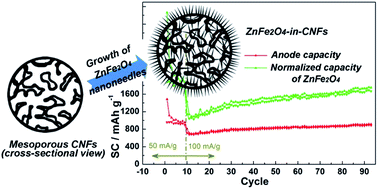Polydopamine-derived porous nanofibers as host of ZnFe2O4 nanoneedles: towards high-performance anodes for lithium-ion batteries†
Abstract
In this work, highly mesoporous carbon nanofibers in free-standing mat form are successfully fabricated by single-spinneret electrospinning of polystyrene (PS) followed by coating the porous PS nanofibers via in situ polymerization of dopamine and subsequent annealing. The pores inside the nanofibers are mainly in the range of 10–50 nm and interconnected to each other, forming nanochannels. ZnFe2O4 crystals can then be grown from the nanofibers via a solution route. Strikingly, ZnFe2O4 nanoneedles are formed, which have diameter and length of about 8 nm and 70 nm, respectively, and are located evenly not only on the surface of the nanofibers but also inside the nanochannels. The ZnFe2O4/carbon composite nanofibers exhibit excellent cyclability and rate performance as anodes of lithium ion batteries (LIBs), in which the ZnFe2O4 nanoneedles are the major active component with normalized capacity of 1000–1700 mA h g−1 at 0.1 A g−1 and 560 mA h g−1 at 5 A g−1, respectively. The excellent properties can be ascribed to the very small diameter of the nanoneedles that ensures complete conversion reactions and alloying/de-alloying between Zn and lithium, the good contact of the nanoneedles with polydopamine-derived N-doped graphitic carbon that offer efficient electrical conduction, and the nanochannels that allow facile transport of the electrolyte and lithium ions.


 Please wait while we load your content...
Please wait while we load your content...